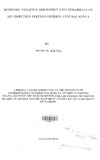| dc.description.abstract | This was a study on domestic violence and women's vulnerability to HIV infection. The
study was carried out in Kinoo Division, Central Kenya. It was done among women and
men who were HIV infected and had enrolled in various HIV support groups. The study
population was identified through their enrollment in the HIV support groups. The unit of
analysis was the individual woman and man who was HIV positive. This was established
based on the membership list of both private and public organizations that were located
within Kinoo area, for example, World Vision, Lea Toto, Christian Children's Fund and
Nyumbani. The sample population consisted of 100 respondents.
The study adopted a descriptive and cross-sectional research design. It combined both
qualitative and quantitative methods of data collection. Data was collected using a
structured questionnaire, key informant interviews, focus group discussions and
secondary data. Qualitative data was analyzed through content analysis and the findings
presented using verbatim quotes and anecdotes. Quantitative data was analyzed using the
Excel computer software package, and the findings presented in tables of frequencies and
percentages.
Cross-tabulated HlV sero-status with demographic and descriptive variables were used to
examine confounds of the relationships.. between violence and HIV infection.
Associations of different experiences of domestic violence with women's sero-status was
examined and tested, for example, lifetime adult violence and current intimate partner
violence.
The study found that women are more willing to come out in the open about their HIV
status while the men are still hiding in denial and fear of confirming their status. The
findings also showed that domestic violence increases women's vulnerability to HIV
infection and that there is an intersection between domestic violence, gender inequality
and HIV infection. It can, therefore, be concluded that double standards are practiced both in
the family and in the society. The men can move out with other women and get infected while it
is taboo for the women to do the same even when not sexually satisfied or deprived of their
sexually rights by their matrimonial spouses. | en |

